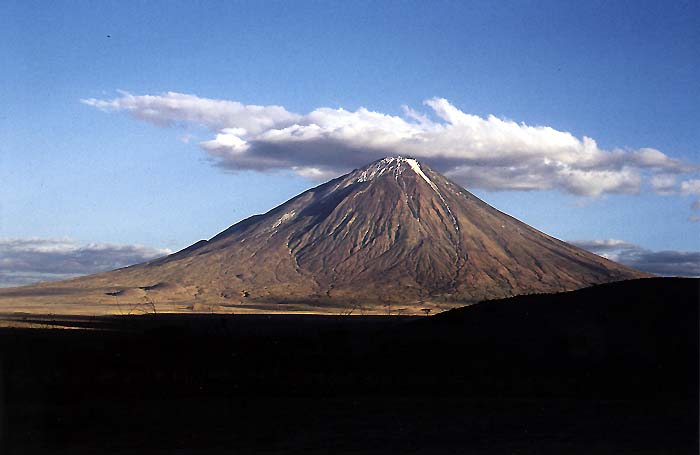1) The fluids emanated from a
subterranean/subvolcanic body of molten rock (magma) that was:
a) Carbonatitic in
composition, possibly in a shallow, rifting sea-floor setting.
b) Granitic in composition
and significantly younger than the H8 marble unit (unlikely in view
of field results).
2) The hydrothermal fluids
were of non-magmatic origin and significantly younger than the H8
marble unit, potentially circulated by magmatic heat, but deriving
their REE from leaching of surrounding rocks, or
3) The deposits are actual carbonatite material crystallized
directly from molten carbonate liquid

 If the H8 marble was volcanic in
origin, it may
have once looked something like the strange carbonatite-type volcanoes
we see today at Ol Doinyo
Lengai
volcano in the
East African
Rift. The Mountain Pass REE deposit in California is also
associated with carbonate-type volcanic rocks. If the H8 marble
represents a carbonate volcanic rock, then the H8 marble may have been
an important source of REE in the deposit. Alternately, some
workers claim the H8 marble was originally deposited as a sedimentary
rock like limestone in a shallow sea (Meng, 1982; Chao et al., 1992,
1995). Because normal sedimentary limestones contain essentially
no REE, a sedimentary origin for the H8 marble would suggest it was not
a potential source for REE, thus requiring some other source for the
REE.
If the H8 marble was volcanic in
origin, it may
have once looked something like the strange carbonatite-type volcanoes
we see today at Ol Doinyo
Lengai
volcano in the
East African
Rift. The Mountain Pass REE deposit in California is also
associated with carbonate-type volcanic rocks. If the H8 marble
represents a carbonate volcanic rock, then the H8 marble may have been
an important source of REE in the deposit. Alternately, some
workers claim the H8 marble was originally deposited as a sedimentary
rock like limestone in a shallow sea (Meng, 1982; Chao et al., 1992,
1995). Because normal sedimentary limestones contain essentially
no REE, a sedimentary origin for the H8 marble would suggest it was not
a potential source for REE, thus requiring some other source for the
REE.